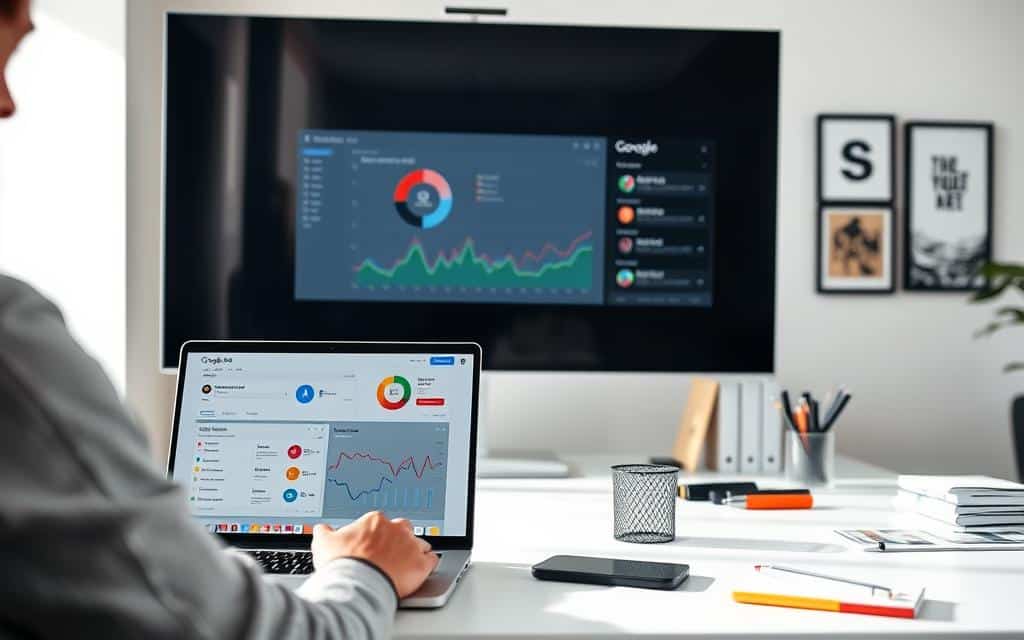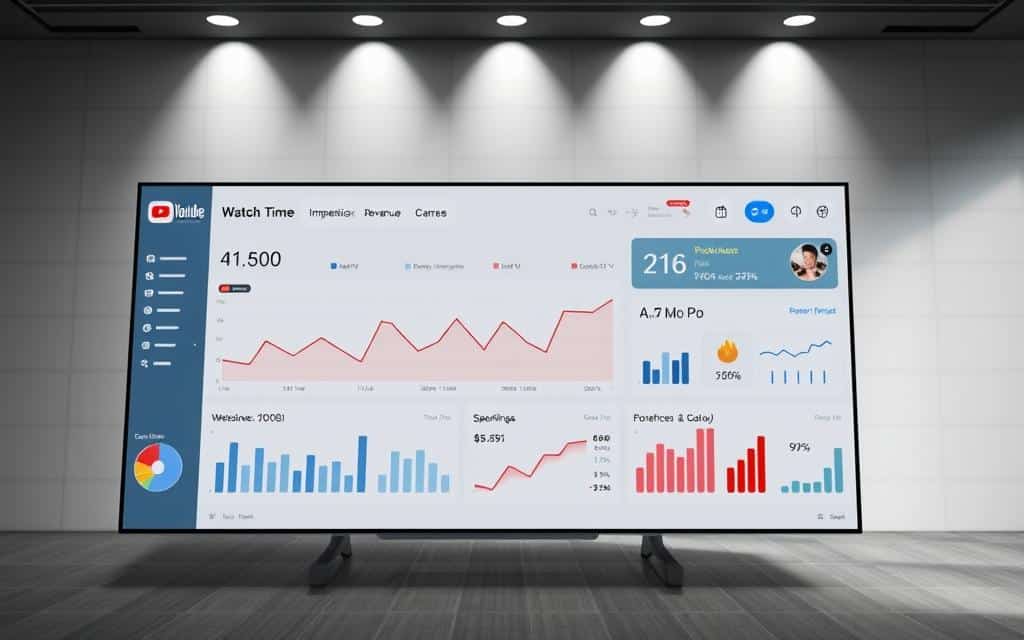Reaching engaged audiences in today’s fragmented media landscape requires innovative strategies. YouTube TV, a leading streaming service blending live TV with on-demand content, offers advertisers a unique platform to connect with viewers. With over 8 million subscribers tuning in for sports, news, and entertainment, this digital-first environment merges the scale of traditional TV with the precision of modern targeting.
Unlike cable, streaming platforms let you deliver video campaigns to specific demographics, locations, and interests. YouTube TV uses Google Ads to place your message before high-intent audiences during live events or popular shows. Whether boosting brand awareness or driving conversions, this guide will show you how to structure campaigns, select formats like non-skippable ads, and optimize budgets for maximum impact.
Key Takeaways
- YouTube TV combines live TV viewership with digital ad targeting capabilities
- Streaming audiences are growing faster than traditional cable subscribers
- Google Ads integration allows precise audience segmentation
- Ad formats include bumper ads and contextually relevant placements
- Campaign success depends on aligning goals with viewer behavior
Introduction to YouTube TV Advertising
Modern marketers face a critical choice: adapt to shifting viewer habits or risk losing relevance. Over 25% of U.S. households have canceled cable subscriptions since 2020, while streaming platforms like YouTube TV gain momentum. This platform merges live broadcasts with on-demand content, creating opportunities to engage audiences across devices.
Why YouTube TV is Essential for Modern Campaigns
Precise targeting separates YouTube TV from traditional options. Unlike cable’s broad approach, Google Ads integration lets you deliver messages based on location, interests, and viewing history. A fitness brand could show ads to gym enthusiasts during sports events, while a local restaurant targets hungry viewers before dinner shows.
Ad formats like non-skippable video spots and 6-second bumper ads ensure your message sticks. These options blend seamlessly with content, maintaining viewer engagement without disruptive breaks. Case studies reveal campaigns using these tools achieve 40% higher brand recall than standard TV ads.
Streaming’s Dominance in Audience Reach
Traditional TV struggles to match streaming’s growth. YouTube TV’s user base expanded 35% year-over-year, outperforming cable providers. Viewers spend 70% more time on streaming services weekly compared to 2019, creating prime opportunities for repeated exposure.
| Metric | YouTube TV | Cable TV |
|---|---|---|
| Under-35 Audience | 63% | 28% |
| Ad Completion Rate | 92% | 76% |
| Targeting Options | 15+ Filters | 3 Basic Filters |
This data proves streaming platforms deliver better campaign performance. By combining TV’s storytelling power with digital precision, you maximize both reach and relevance. The next sections explore setup processes and optimization tactics to capitalize on these advantages.
Understanding the YouTube TV Platform
Streaming services have rewritten the rules of audience connection. YouTube TV combines live broadcasts with a library of on-demand shows, letting viewers watch sports championships or binge dramas anytime. Unlike cable boxes gathering dust, this platform works across phones, tablets, and smart TVs—no fixed schedules required.
Flexibility Meets Precision in Modern Viewing
Three features define YouTube TV’s edge:
- Cloud DVR: Record 500+ hours of live TV without storage limits
- Multi-device access: Stream on 3 screens simultaneously
- Exclusive events: Live sports and premieres unavailable elsewhere
Cable providers can’t match this agility. While traditional packages lock you into 200+ channels, YouTube TV offers customizable add-ons. A study by Nielsen shows streaming users engage 47% longer with ad-supported content than cable viewers.
| Feature | YouTube TV | Traditional Cable |
|---|---|---|
| Contract Flexibility | Month-to-month | Annual commitments |
| Content Access | Any device, anywhere | Home-based hardware |
| Ad Integration | Google Ads targeting | Generic regional slots |
This infrastructure lets campaigns adapt in real time. Pair Google Ads’ location filters with trending shows to boost relevance. Viewers watching cooking programs might see kitchenware ads, while sports fans get fitness gear promotions—all without disrupting their experience.
how to advertise on youtube tv: Getting Started with Your Campaign
Streaming platforms require seamless technical integration for campaign success. Connecting your Google Ads account to YouTube unlocks precise audience insights and unified campaign controls. This foundational step ensures your ads reach viewers across live and on-demand content effectively.
Linking Your Google Ads and YouTube Channels
Follow these steps to merge your accounts:
- Sign into Google Ads using your brand’s credentials
- Navigate to Tools & Settings > Linked Accounts
- Select YouTube from the platform list and authorize access
Linked accounts provide cross-platform benefits. You gain real-time data on viewer interactions and ad skip rates. Marketing teams using this integration report 28% faster optimization cycles compared to manual tracking.
| Feature | Linked Accounts | Unlinked Accounts |
|---|---|---|
| Performance Tracking | Unified dashboard | Separate reports |
| Audience Data Access | Full demographics | Limited insights |
| Billing Management | Single interface | Multiple logins |
Verify billing details before launching campaigns. Payment methods must match across both platforms to avoid approval delays. A fitness apparel brand recently streamlined their setup this way, reducing campaign launch time from 14 days to 72 hours.
Integrated management lets you adjust bids based on viewer engagement patterns. Test different creative variations while maintaining consistent audience targeting parameters. This approach maximizes every dollar spent across YouTube’s streaming ecosystem.
Setting Up and Managing Your YouTube TV Campaigns
Launching effective campaigns demands more than creativity—it requires precision in setup. Proper configuration of your advertising tools ensures every dollar spent delivers measurable results. This section breaks down the essentials for building campaigns that resonate with streaming audiences.

Creating and Configuring a Google Ads Account
Start by visiting ads.google.com and clicking “Start Now.” Choose “Create a New Account” using your brand email. Verify business details like location and industry to unlock advanced targeting features.
Navigate to Settings > Billing to add payment methods. Enable automated payments for uninterrupted ad delivery. Campaign preferences should match your streaming objectives—select “Video” as the campaign type to access YouTube TV placements.
Selecting the Right Campaign Goals and Ad Formats
Google Ads offers three primary objectives for streaming campaigns:
- Brand Awareness: Prioritizes impressions for new audiences
- Product Consideration: Targets viewers researching similar items
- Conversions: Optimizes for specific actions like website visits
Non-skippable 15-second ads work best for storytelling, while 6-second bumper ads reinforce messages during live events. A recent Nielsen study showed campaigns combining both formats achieved 22% higher engagement than single-format approaches.
Test different creatives using the A/B experiment tool. Rotate versions weekly based on watch-time metrics. Link your Google Ads account to Google Analytics for cross-platform performance tracking.
Targeting, Budgeting, and Optimization Strategies
Streaming platforms demand smarter audience engagement approaches than traditional methods. Successful campaigns balance laser-focused targeting with flexible budget allocation. Start by dissecting viewer data to identify high-value segments.
Audience Segmentation Through Precision Filters
Google Ads offers 15+ demographic filters to refine your approach. Combine age ranges with interest categories like “Home & Garden” or “Fitness Enthusiasts.” Behavior filters track actions like recent purchases or video watch history.
Device targeting ensures ads appear where viewers engage most. Smart TV placements dominate evening hours, while mobile devices peak during commutes. A kitchenware brand increased conversions 27% by prioritizing smart TV ads during cooking shows.
Smart Budget Allocation for Maximum Impact
Set daily budgets based on peak viewing times. Use Target CPM bidding for brand awareness campaigns and Target CPA for conversion-focused efforts. Monitor these metrics weekly:
| Metric | Ideal Range | Adjustment Trigger |
|---|---|---|
| View Rate | 15-25% | Below 10% |
| CPV | $0.10-$0.30 | Above $0.50 |
| Engagement | 30+ Seconds | Under 15 Seconds |
Optimize bids every 72 hours using performance data. A travel company reduced CPA by 35% after shifting budgets from mobile to connected TV during weekend prime time. Always test new audience segments with 10-15% of your budget to uncover hidden opportunities.
Continuous refinement separates thriving campaigns from stagnant ones. Update creative assets quarterly to match seasonal trends and viewer preferences.
Analyzing Performance and Overcoming Advertising Challenges
Streaming campaigns live or die by their ability to adapt. Real-time analytics transform raw data into actionable insights, letting you refine strategies while viewers engage. Google Ads’ dashboard updates every 90 seconds, showing which creatives resonate and where adjustments matter most.

Measuring Success with Real-Time Analytics and Metrics
Focus on three core metrics to gauge effectiveness:
- Click-through rate (CTR): Measures ad relevance (aim for 0.5-1.5%)
- Cost per view (CPV): Tracks budget efficiency (keep under $0.30)
- Conversion rates: Reveals campaign impact on sales or sign-ups
Third-party tools like Nielsen Digital Ad Ratings validate audience reach. Compare demographic data against your goals to spot mismatches. A recent campaign for a skincare brand found 65% of viewers were outside their target age range—insights that prompted immediate creative changes.
| Metric | Benchmark | Optimization Tip |
|---|---|---|
| CTR | 0.8% | Test shorter pre-roll ads |
| CPV | $0.25 | Pause low-performing placements |
| View Completion | 70% | Shorten mid-roll ad lengths |
Addressing Limitations and Refining Your Approach
Regional restrictions often limit audience size. Counter this by creating location-specific ad variations. For areas with strict targeting rules, focus on broader brand awareness goals instead of direct response.
“Agility separates top performers. Update creatives weekly based on engagement patterns, not monthly reports.”
Rotate bidding strategies every 14 days. Start with Target CPM to build awareness, then switch to Maximize Conversions for high-intent periods. Always allocate 10% of your budget to test new audience segments—you might discover untapped markets.
Conclusion
Effective digital campaigns now demand precision and adaptability. YouTube TV’s advertising tools merge traditional TV’s reach with modern targeting capabilities, creating unmatched opportunities to engage streaming audiences. By linking Google Ads accounts, selecting optimal formats like bumper ads, and refining budgets based on real-time data, brands achieve measurable results.
Successful campaigns thrive on strategic adjustments. Use demographic filters to align messages with viewer interests and device preferences. Monitor metrics like CPV and CTR weekly, reallocating funds to high-performing placements. Platforms offering 15+ targeting options ensure your ads reach the right eyes during key moments.
Ready to elevate your strategy? Begin crafting campaigns that combine Google’s analytics with YouTube’s streaming dominance. Explore advanced resources for tracking cross-platform performance, then launch your first ad set. The future of audience connection starts now—take action today.